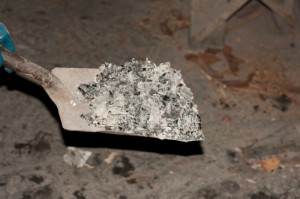If you own a wood-burning fireplace, then you’re no stranger to ash. If large amounts of ash are present in your fireplace, then it’s likely time to remove it. Ash can draw in moisture, causing rust throughout the fireplace, and it can have damaging effects on your fireplace grate, too. Along with this, a big pile of ash means less room in your firebox for fuel! It’s important to remove ash from time to time to ensure optimal performance from your fireplace.
That being said, ash should always be removed with the proper equipment and stored in a safe location to ensure your home and family stay safer throughout the burning season. Learn more about this process below, then count on us, the Lords Chimney team, to handle your fireplace repairs, inspections, sweepings, and more!
Invest In Good Tools
It’s important to set yourself up with appropriate tools before getting started. You’ll always want to use a metal scoop to remove the ash from your fireplace. Live embers can remain present for days in your ash pile, so it’s best to use tools that are non-flammable and that reduce any risk of injury.
The next thing you’ll need is a container to the put the ashes into. You’re best bet is investing in one meeting these specific guidelines:
– The bucket should be metal or another non-flammable material to minimize the risk of house fires.
– You’ll want to find a bucket. that’s bottom is slightly raised. If stray embers heat up again, it could cause some charring on your floor should the metal bottom be in contact with it
– The container should have a tight-sealing lid, so that no oxygen has access to your ash pile. Oxygen fuels fires, so a lid will ensure that nothing can be reignite while you wait for your ash pile to properly cool.
– Get a bucket with a strong handle to ensure safe and easy transportation.
Storing Safer
Once your bucket is full, store it on a non-flammable surface, such as metal, concrete, brick, or something similar. Wait at least a few days before doing anything else with the ash to avoid the risk of fire. By going through these quick and easy steps, you’ll be able to safely store your ash all season long!
It’s OK To Leave A Layer Behind
Keep in mind that leaving a small layer of ash (around 1 inch) behind throughout the burning season is okay, and it may actually help you out in the long run! This layer makes building future fires easier, and it helps maintain good heat, too. It also helps protect your firebox floor and discourages build up and debris accumulation. Finally, clear out the excess ash once you’re done with your fireplace for the year.
As always, be sure to turn to Lords Chimney for all your fireplace needs. We’re here to serve you!
If you own a wood burning stove or fireplace, you have probably disposed of buckets and buckets worth of ash throughout the course of time. Most homeowners simply wait for their ash to cool, then throw it out with trash. However, there are a lot of ways you could use this substance a bit more resourcefully. Check out some great ways to utilize your ash pile, so you get the most out of every fire you burn!
Enrich Your Soil
If you are an avid gardener, then put some ash into your soil to amp up your gardening game. Just be careful which plants you add it near. Watch your pH levels, as ash will increase them, and steer clear of adding it to plants that thrive in acidic soil, like berries, fruit trees, rhododendrons, or azaleas. Tomatoes are a great example of a plant that would benefit from the addition of ash, as well as onion, broccoli, and cabbage.
Another gardening tip is to sprinkle ash around the outside of your garden beds to keep nasty pests away. Ash repels snails and slugs, and it helps in keeping out harmful diseases, as well. If you are a green thumb, fireplace ash can work wonders for your plants!
Make Cleaning Easier
Believe or not, ash can help a lot when it comes to cleaning around the house. If your fireplace doors are looking a bit foggy, dip a wet sponge or towel in your ash pile, then scrub away. You could also try the same technique, just with newspaper – it’s known for making your doors sparkle! Try it on your home’s windows, as well, to get off any stubborn dirt or debris.
Ash is also great for polishing silver, and the best part? It’s completely natural! Store bought products typically contain toxins that could cause damage throughout time. Instead, mix a little water in with some ash until a paste forms, then spread it on your silver. After a few minutes, wipe it clean, buff it, and your dishes and silverware will look good as new!
Other Uses
We’ve mentioned a few things you can do with ash, but the list could go on and on! If you are looking for a fun project, try using it to make some soap! Look up tutorials online for a fun way to spend your day or let your kids give it a shot. It also helps to hide paint stains on paving, and even removes pet odor from your furry critter’s coat! Rub in a handful to your dog or cat’s fur next time you give them a bath and get rid of any unpleasant smells with ease.
Always Remove Ash
Remember to clean out your ash on a regular basis to ensure strong fires and a healthy, long-lasting fireplace. A small layer is fine and can be helpful when starting up fires, but anything too thick should be scooped out and disposed of properly.
Learn more about safe ash removal and chimney sweeping today by calling on the certified pros at Lord’s Chimney. We can assist with any and all of your fireplace needs!
A roaring fire can be a welcome sight during the cold months of winter. To keep their fireplaces running properly, homeowners know to have their chimneys swept and inspected each year. However, few pay much attention to what they do with the byproducts of their wood burning fires – the ashes.
Regular ash disposal can improve the efficiency of your fireplace, and properly disposing of ashes can prevent accidental fires. Rather than seeing the measures needed to properly remove ashes as an inconvenience, homeowners should instead see it as taking steps to ensure their family’s safety.

How can ashes be dangerous?
While ashes themselves pose little to no threat to you or your family’s safety, it’s what they can keep hidden that are the real danger. Small coals and embers can lay dormant when surrounded by ash, only to ignite later on. According to forestry officials, “Wood ashes retain enough heat to ignite other combustible materials for several days.” Because of this, all ashes should be treated with caution, especially those from recently extinguished fires.
Improper ash removal methods
Unfortunately, many of the most common methods of ash removal are also the most unsafe. Ashes should never be mixed with garbage or trash; this even includes putting cold ashes into regular trash cans or dumpsters. Likewise, ashes should never be transported in cardboard boxes, paper bags, or other combustible containers. Lastly, vacuums should not be used to clean up ashes unless they have a HEPA filter. Without an appropriate filter to prevent dust particles from becoming airborne, even shop vacuums may leave carpets, walls, and other furnishings coated with a fine layer of dust.
Proper ash removal
The first and most important step in ash removal is ensuring that there are no remaining hot coals or embers in the ashes. This can often be achieved by letting a fire extinguish naturally overnight and stirring the ashes the next morning to ensure there are no remaining hot spots or pockets of heat. Ashes can then be transferred into a specially designed metal ash container that has a tight fitting lid. Ash containers should never be stored indoors, in garages or sheds, or near combustible materials in case there any remaining coals or embers.
Alternative uses of ashes
After using your wood burning fireplace all winter long, you may find yourself with a surplus of ashes. Luckily, there are several alternative ways that ashes can be used around the home. Two of the most popular uses for ashes are in the garden: as a fertilizer or as a bug repellant.
As a fertilizer, small amounts of ash can be used on garden plots or in compost piles. Ash “improves root health and strengthens the very cellular structure of plants, helping them resist all kinds of stresses,” says Julia Gaskin. Likewise, when sprinkled around the edges of a garden plot or flower bed ashes can serve as a natural repellent for slugs and snails.
Lastly, ashes can be sprinkled on icy driveways or sidewalks as an alternative to salt or gravel to prevent slipping. However, homeowners and their guests should take special care to wipe the soles of their shoes off after walking on an ashy path. If not, you may accidentally track dirty footprints throughout the house!
Properly removing and disposing of ashes can protect your family against accidental accidents or fires, and ashes can also have a surprising number of uses around the home. If you have questions about ash disposal or how to help your wood burning fireplace burn more efficiently, contact Lord’s Chimney today!


